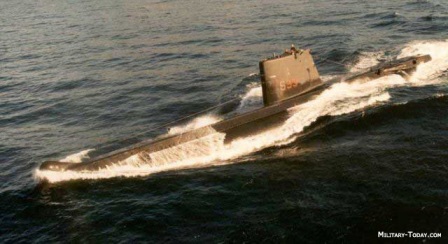Daphné-class
Summary
| Origin country | 🇫🇷 France |
| Category | Submarine |
| Subtype | Attack submarine |
| Manufacturer | DCN, Brest & La Ciotat |
| Year commissioned | 1964 |
| Units | S98 UMKHONTO, S99 ASSEGAAI. S62 TONINA, S63 MARSOPA. S164 BARRACUDA, S166 DELFIM. 131 HANGOR, 132 SHUSHUK, 133 MANGRO, 134 GHAZI |
Description
The Daphné-class submarines were French diesel-electric powered vessels that first entered service in 1964. Constructed by the French defense contractor DCNS, they were initially used by the French Navy and later marketed for export. Eleven units served in the French fleet, while export models were operated by other countries including South Africa, Pakistan, Portugal, and Spain. Some countries developed their own subclasses based on the Daphné design. However, the accidental sinkings of two French submarines, Eurydice in 1970 and Minerve in 1968, due to a flawed snorkel design, resulted in halted sales. The class was eventually retired, with the last submarines being scrapped in the 1990s. Portugal also sold one submarine to Pakistan during this period.
The design of Daphné-class submarines featured twelve torpedo tubes - eight at the front and four at the stern. The tubes could accommodate French 550 mm diameter torpedoes. The forward tubes were capable of launching full-length torpedoes for engaging surface ships and submarines, while the shorter stern tubes were used solely for self-defense against submarines. Design-wise, Daphné-class submarines had forward diving planes located below the hull's midplane, which differed from modern German submarines by being non-retractable or foldable but instead operated by tilting.
Operational history for the Daphné-class includes various milestones and notable events. The French Navy's fleet comprised eleven submarines, some of which served for over 30 years before decommissioning, with one, the Flore, being preserved as a museum ship. In Pakistan, the PNS Hangor gained historical significance by sinking the Indian frigate INS Khukri during the 1971 Indo-Pakistani war. Pakistan eventually retired this class of submarines to replace them with newer models. The Portuguese Navy's Albacora-class consisted of four submarines built using the Daphné design. In South Africa, three submarines were acquired, with one, the SAS Assegaai, being converted to a museum ship. The Spanish Navy operated the Delfín-class, which consisted of four submarines constructed in Spain at the Cartagena dockyard, eventually decommissioning them between 2003 and 2006, with plans to preserve several as museum ships.
Countries that operated the Daphné-class submarines included France, with eleven units; Pakistan, with three originally built for them and one added from Portugal; Portugal, with four units; South Africa, also with three units; and Spain, with four units constructed domestically. The submarines served various lengths of operational service, with some being preserved as museum ships for historical and educational purposes after decommissioning.
Technical specifications
| Daphné | |
|---|---|
| Displacement | 869 tons |
| Displacement submerged | 1043 tons |
| Range | 18000 km |
| Endurance | 30 days |
| Crew | 50 members |
| Width | 6.74 m (22.1 ft) |
| Length | 57.75 m (189.5 ft) |
| Max. depth | 250 m (820.2 ft) |
| Propulsion | 2 SEMT Pielstick 12 PA 4 diesel engines with a power of 1,800 hp - 2 propellers |
| Armament | 12 550mm TLT (12 torpedoes) |
| Maximum speed | 15 knots |
| Max. speed submerged | 16 knots |
Photo of Daphné class
